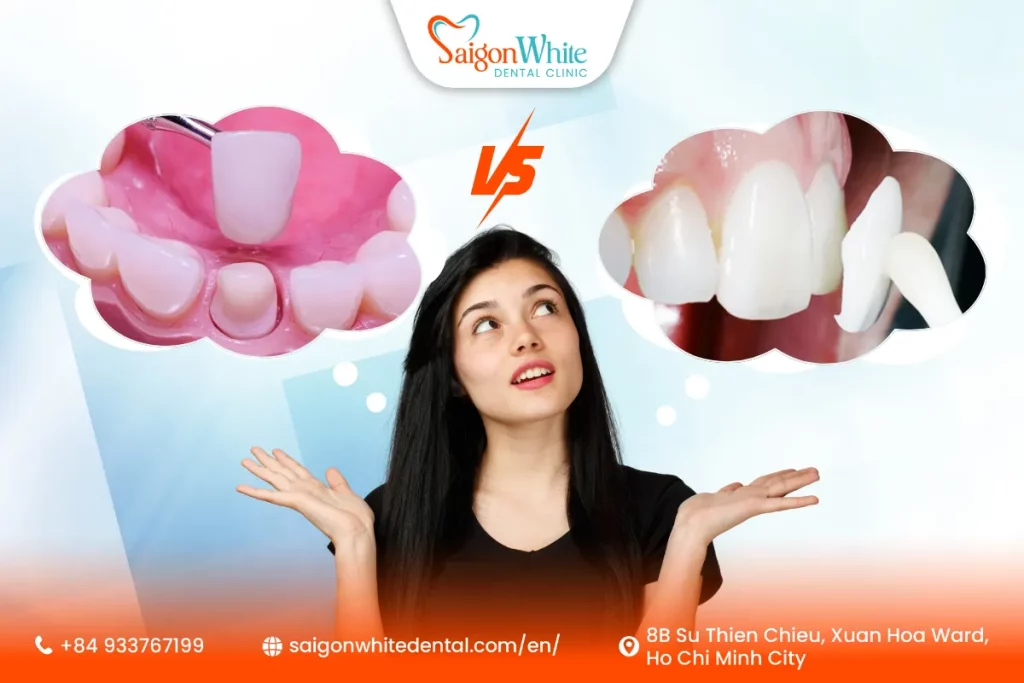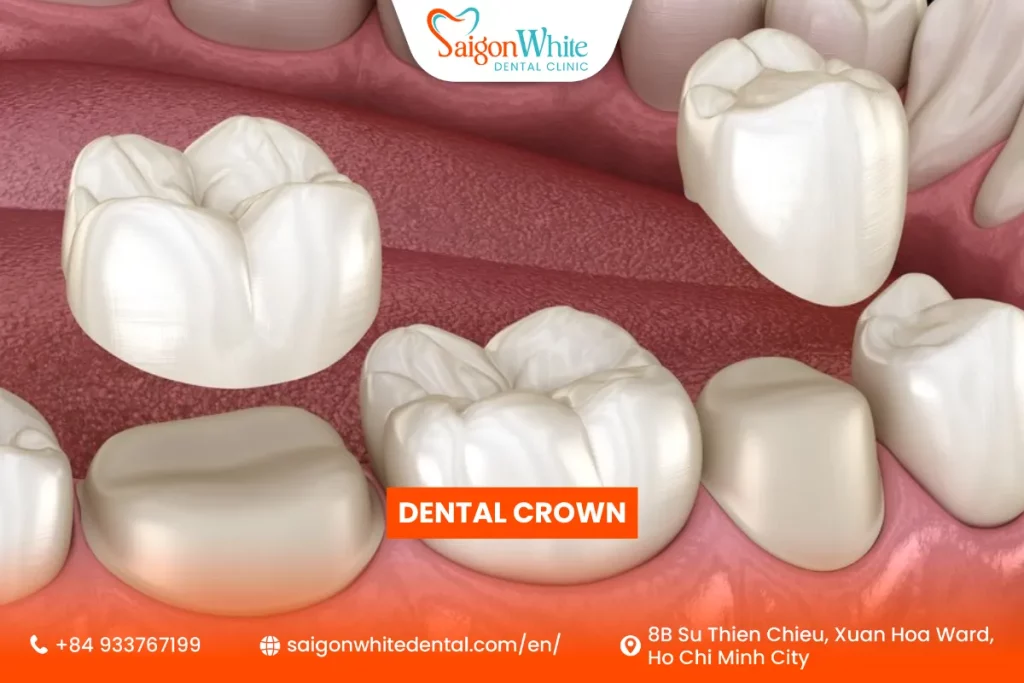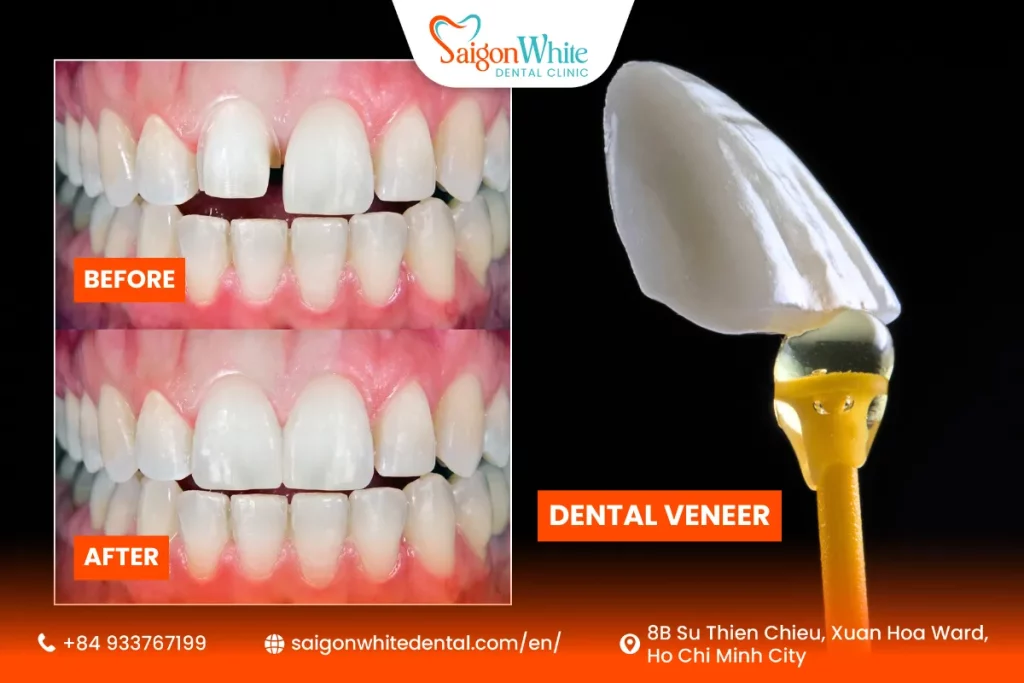Understanding the difference between a dental crown and a veneer is essential for anyone considering cosmetic or restorative dental treatments. These two popular options may seem similar at first glance, but they are designed for different purposes and conditions.
While both can dramatically improve the look of your smile, choosing the right solution depends on your specific dental needs.
This guide explains the difference between a dental crown and a dental veneer helping you make informed decisions about your dental care.

What Is a Dental Crown?
A dental crown is a tooth-shaped “cap” that covers the entire visible portion of a tooth — not just the front, but all around and over the top. It’s designed to restore a tooth’s shape, size, strength, and appearance.
Crowns are often used to protect weak or damaged teeth or to complete a restorative treatment such as a root canal.

Common Materials for Dental Crowns:
- Porcelain or Ceramic: Matches natural tooth color
- Zirconia: Very strong and esthetic
- Metal (Gold or Alloys): Durable but less aesthetic
- Porcelain-fused-to-metal (PFM): Aesthetic + strong
When Are Crowns Used?
- To restore broken, cracked, or worn-down teeth
- To cover and protect a tooth after a root canal
- To hold a dental bridge in place
- To cover a dental implant
- To improve severely discolored or misshapen teeth
How Is a Crown Installed?
The dentist will shape the tooth (remove some of its structure), take impressions, and then place a custom-made crown that fully encases the tooth.
What Is a Veneer?
A dental veneer is a thin shell, usually made of porcelain or composite resin, that covers only the front surface of the tooth. Veneers are primarily cosmetic, designed to improve the appearance of teeth that are discolored, chipped, slightly misaligned, or uneven.

Types of Veneers:
- Porcelain Veneers: Durable, natural-looking, and stain-resistant
- Composite Veneers: Quicker to apply, more affordable, but less durable
Common Uses for Veneers:
- Covering stained or yellowed teeth that don’t respond to whitening
- Closing small gaps between teeth
- Fixing minor chips or irregularly shaped teeth
- Creating a more symmetrical smile
How Are Veneers Applied?
A small amount of enamel is removed from the front of the tooth. Then, the custom veneer is bonded directly onto the front surface.
Key Differences Between Crowns and Veneers
Although both crowns and veneers can enhance the appearance of teeth, they are not interchangeable. They differ in terms of coverage, purpose, strength, cost, and when they are used.
Here is a side-by-side comparison:
| Criteria | Crown | Veneer |
| Coverage Area | Covers the entire tooth (front, back, top, and both sides) | Covers only the front surface of the tooth |
| Primary Purpose | Restoration and protection of weak, broken, or heavily decayed teeth | Cosmetic enhancement: color, shape, small gaps, minor misalignment |
| Tooth Reduction Required | Requires more tooth structure removal (60–75%) | Minimal enamel removal (0.3–0.7 mm), preserves natural tooth structure |
| Common Materials | All-ceramic, porcelain-fused-to-metal, zirconia, lithium disilicate | Emax porcelain, ultra-thin porcelain, composite resin |
| Durability | Very strong – excellent for chewing forces, lasts 10–15+ years | Good durability – typically lasts 7–10 years with proper care |
| Aesthetic Results | Natural look, but may be slightly less translucent due to thickness | Excellent aesthetics – translucent like natural enamel, ideal for smile makeovers |
| Cost | Generally more expensive (due to strength and complexity) | It may be cheaper per tooth, but full smile cases can be costly |
| Best for These Conditions | Severely decayed, broken, worn-down teeth, root canal-treated teeth, and implant crowns | Discolored, chipped, gapped, and slightly crooked front teeth that are otherwise healthy |
| Procedure Time | Requires 2–3 appointments (prep, temporary crown, final placement) | Typically 2 appointments, often quicker and less invasive |
| Tooth Preservation | Requires more removal of tooth structure | Maximally preserves the natural tooth |
| Post-Treatment Suitability | Suitable for teeth with root canal treatment or severe damage | Not suitable for weak or structurally compromised teeth |
When Is a Crown the Better Choice?
Dental crowns are often the preferred solution when the tooth is structurally compromised or has undergone extensive damage. Here are the most common scenarios:
Severely Decayed Teeth
If a tooth has large cavities that weaken its structure, a filling or veneer won’t provide enough support.
→ A crown is necessary to restore full strength and function.
Cracked or Broken Teeth
When a tooth is fractured or broken—especially if it involves the chewing surface or root—
→ A crown helps protect and hold the tooth together, preventing further damage.
After Root Canal Treatment
Teeth that have undergone a root canal become brittle and more prone to breaking.
→ Crowns are essential to protect and seal the tooth afterward.
Worn-Down Teeth
Excessive grinding (bruxism) or acid erosion can wear down enamel.
→ Crowns rebuild the original shape and height of teeth, improving both appearance and bite function.
Replacing Large Fillings
Old or oversized fillings can weaken the tooth structure.
→ A crown offers better long-term support than renewing the filling again.
Support for Dental Bridges
Crowns are often used to anchor dental bridges by covering the teeth on either side of a missing tooth.
→ They act as stabilizing pillars for the bridgework.
To Cover Dental Implants
When you receive a dental implant, the visible part of the tooth is restored using a crown.
→ It mimics the natural look and function of a real tooth.
Cosmetic Restoration + Structural Need
If you want both cosmetic improvement and structural reinforcement (e.g. badly stained tooth with cracks),
→ A crown addresses both form and function better than a veneer.
When Is a Veneer the Better Choice?
Dental veneers are ideal when the goal is cosmetic enhancement and the natural tooth is still structurally sound. Here are the key situations where veneers are preferred:
To Improve Tooth Color
If your teeth are deeply stained or discolored (due to antibiotics, fluorosis, or old fillings) and whitening treatments don’t work:
→ Veneers can instantly create a brighter, whiter smile.
To Correct Minor Chipping or Cracks
For small chips or hairline cracks that don’t affect the tooth’s strength:
→ Veneers offer a minimally invasive solution while restoring the tooth’s appearance.
To Close Small Gaps (Diastema)
Veneers are excellent for closing small spaces between front teeth without the need for orthodontic treatment.
→ They reshape the teeth to fill in the gaps naturally.
To Fix Slight Misalignment or Uneven Teeth
If your teeth are slightly crooked, uneven, or have mild rotation—but you don’t want braces or aligners:
→ Veneers can create the appearance of perfectly aligned teeth.
To Reshape Short, Worn, or Misshapen Teeth
Teeth that are naturally small, stubby, or worn can be lengthened and reshaped with veneers.
→ This enhances smile symmetry and proportion.
For Smile Makeovers
Want a full smile transformation without extensive dental work?
→ Veneers are often the top choice for Hollywood-style makeovers, giving uniform shape, color, and brightness.
When Tooth Structure Is Mostly Healthy
If the tooth is healthy with no major decay, fracture, or root canal history:
→ Veneers are preferred because they require minimal enamel removal and preserve more of the natural tooth.
Longevity and Maintenance: Crowns vs Veneers
Dental Crown Lifespan
- Lasts 10 to 15+ years (some up to 20+ with excellent care)
- Very durable for both front and back teeth
- Requires regular dental check-ups to monitor integrity
Veneer Lifespan
- Porcelain veneers last about 10–15 years
- Composite veneers last about 5–7 years
- More prone to chipping or staining (especially composite)
Maintenance Tips for Both:
- Brush twice daily and floss carefully
- Avoid biting hard foods or objects (pens, ice, nails)
- Use a nightguard if you grind your teeth
- Schedule regular dental cleanings every 6 months
Cost Comparison: Crowns vs Veneers
The cost of crowns and veneers can vary depending on the material, tooth location, and clinic location. Here’s a general estimate:
| Treatment | Average Cost (USD) | Notes |
| Porcelain Crown | $800–$2,000 per tooth | Durable, aesthetic, full coverage |
| Zirconia Crown | $900–$2,500 per tooth | Premium strength and aesthetics |
| Porcelain Veneer | $600–$1,800 per tooth | Natural appearance, cosmetic use |
| Composite Veneer | $250–$800 per tooth | Less durable, more affordable |
In Vietnam, especially at reputable clinics like Saigon White Dental, the cost can be 50–70% lower than in the U.S., Australia, or Europe — while still maintaining international quality.
Which One Is Right for You?
Choosing between a crown and a veneer depends on several factors:
Consider:
- Is the tooth damaged or just discolored?
- Has it had a root canal?
- Do you grind your teeth?
- What is your budget?
- Are you aiming for a function or cosmetic change?
The best way to know for sure is to consult with a dentist. They’ll assess your tooth health, bite alignment, and goals to recommend the most suitable solution.
Conclusion
While both dental crowns and veneers can enhance your smile, they serve different purposes. Crowns offer full protection and strength for damaged teeth, while veneers are a minimally invasive cosmetic solution for enhancing beautiful, healthy smiles.
Choosing the right option depends on your oral condition, aesthetic goals, and long-term dental health plan.
Considering a Smile Makeover or Tooth Restoration?
At Saigon White Dental, we specialize in both veneers and crowns, offering customized treatment plans tailored to your smile and budget. Whether you’re dealing with a broken tooth or simply want a brighter, more symmetrical smile, we’re here to help.
📍 Visit us in Ho Chi Minh City
📞 Schedule your consultation today

 Telegram
Telegram